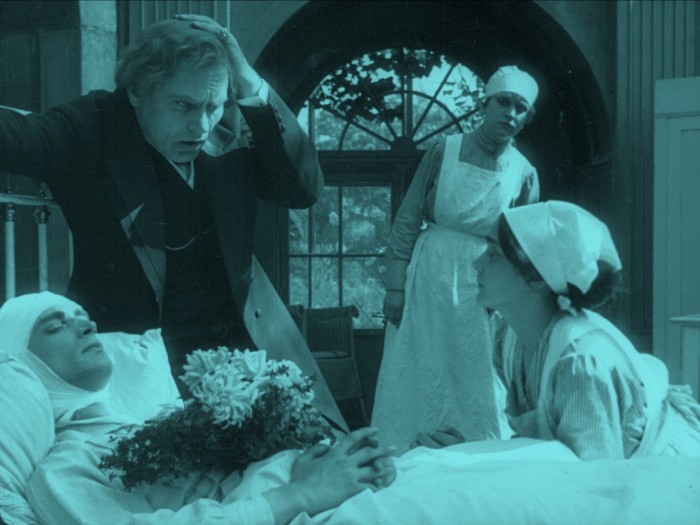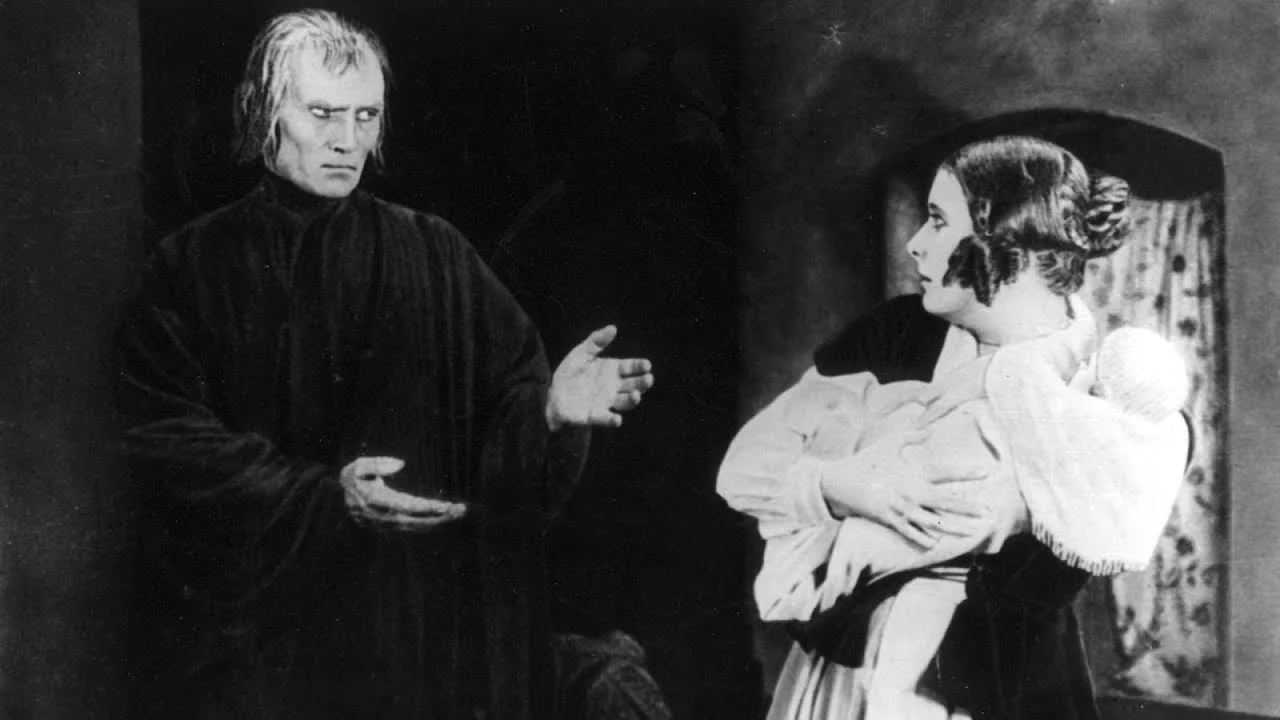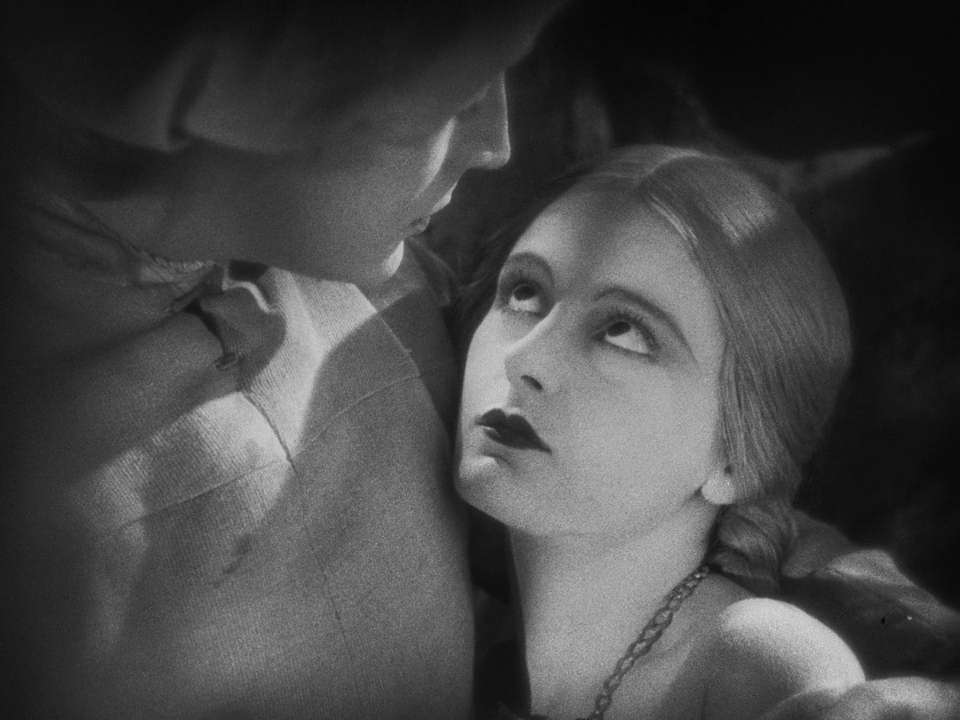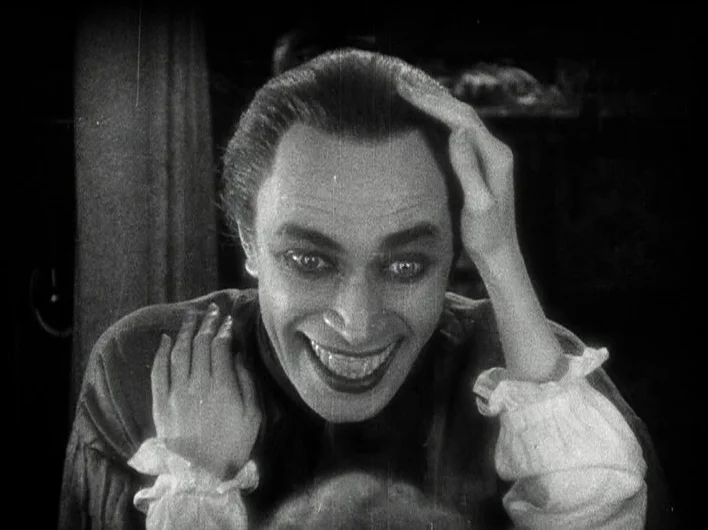https://www.movementsinfilm.com/blog/german-expressionist-films-1919-1931
German Expressionist Films (1919 - 1931)

METROPOLIS (CREDIT: UFA/PARUFAMET)
By 1912, film was still commonly disputed as a legitimate artform within Germany, with many theatre professionals boycotting the industry entirely. Whether they genuinely considered it to be lowbrow entertainment or simply wanted to protect their own industry is unclear, but in either case the boycott ultimately failed. By 1913, this opinion had largely faded and many of the industry's naysayers were contracted by the very studios they had opposed. The concept of 'Autorenfilm' arose, by which a famous writer would become the selling point for a film's production - particularly if the writer had created the film's source material. Although Stellan Rye's The Student of Prague (1913) saw notable success through this technique, the concept of Autorenfilms soon lost the attention of the filmgoing audience and studios were once again looking for a way to capture people's imagination. Then came a blessing in disguise, at least from the studios' perspective.
In 1916, the German government had become dissatisfied with the popularity of foreign films, particularly those they believed to be attacking Germany. It was decided that all foreign films would be banned for the foreseeable future, allowing domestic studios to completely corner the market and produce considerably more films each year to greater success. By 1920, this increase in supply and demand had clearly led to a boom in the industry, allowing German Expressionist directors such as F. W. Murnau, Fritz Lang, Robert Wiene and Lupu Pick to develop unconventional storytelling for the masses.
These directors proved that, perhaps better than any other medium before it, film allows us to visually and existentially explore the dark corners of human psychology. With stories of despair, betrayal and the occasional sign of hope, the movement established staples of the horror genre - but its influence also stretches much further. From immediately recognizable designs in Star Wars to the character development for Batman's Joker, German Expressionists initiated the beginnings of many pop culture landmarks we see today. Below you'll find a brief timeline of the films that formed the movement from 1919 until 1931, along with the context in which they were created.
Nerves (1919) Nerven – by director Robert Reinert

NERVES (1919) CREDIT: SÜDDEUTSCHES FILMHAUS
When the leader of a rebellion is accused of rape, a court case ensues. Nerves explores the lives of Germans with varying social status. Focusing on a factory worker, a celebrated teacher and a soon-to-be revolutionary, the film allows director Robert Reinert to delve into Germany's post-WWI 'nervous epidemic' and the relationship between a character's woes and their mental health.
Opium (1920) by director Robert Reinert

OPIUM (1920) CREDIT: STERN-FILM
A professor researching the effects of opium is told about a particularly effective opiate. While seeking out the deadly drug, he meets a woman in despair.
Director Robert Reinert would sign a contract with film studio UFA (Universum-Film Aktiengesellschaft) from 1925, but died from a heart attack just three years later.
Power (1920) Algol - Tragödie der Macht – by director Hans Werckmeister
A coal miner obtains a powerful device from an extraterrestrial from the planet Algol (explaining the film's original title). Despite intentions to use the machine as a force for good, the miner's actions have unexpected implications. Notably, Power's set design was constructed by Walter Reimann, who made history with his work on The Cabinet of Dr. Caligari in the same year.
The Cabinet of Dr. Caligari (1920) Das Cabinet des Dr. Caligari – by director Robert Wiene

THE CABINET OF DR. CALIGARI (CREDIT: DECLA-BIOSCOP)
A sinister hypnotist called Dr. Caligari uses a somnambulist to commit murders. Writers Hans Janowitz and Carl Mayer used the film to express their distrust of authoritarian figures, a belief that was inspired by the pacifistic duo's experiences throughout WWI. At the time of the film's release, foreign restrictions on German films were starting to become more relaxed, perhaps explaining why The Cabinet of Dr. Caligari had a greater impression on American cinema than Robert Reinert's Nerves, which was released one year earlier and had explored similar themes.
The Cabinet of Dr. Caligari is often considered to be the quintessential German Expressionist film. It's celebrated for its striking visual style, painting harsh lines and intense shadow contrasts onto the film's set designs to create a representation of the character's subjective reality. This distinctive style was adopted by Tim Burton for films such as The Nightmare Before Christmas and Edward Scissorhands, and its influence on the horror genre cannot be overstated.
From Morn to Midnight (1920) Von morgens bis mitternachts – by director Karl Heinz Martin
A Cashier embezzles a wealthy Italian woman and leaves his small provincial home for the capital. Based on the play by Georg Kaiser, From Morn to Midnight is considered to be one of the most radical German Expressionist movies. From Morn to Midnight explores themes of wealth, greed and tumultuous pursuits for satisfaction. The film has five acts, and boasts avant-garde set design from Robert Neppach, whose art direction would go on to have an enduring influence on the movement as a whole.
Genuine (1920) Genuine, die Tragödie eines seltsamen Hauses – by director Robert Wiene
An artist's portrait of Genuine, a high priestess, magically comes to life. She is imprisoned by an eccentric Lord, spurring a nightmarish series of events as she fights for her freedom. In stark contrast to Robert Wiene's other release in the same year, The Cabinet of Dr. Caligari, Genuine was generally disliked upon release, perhaps due to the film's unusual narrative thread. It is, however, a great example of the extent to which directors like Wiene were willing to experiment with complex narratives throughout the Expressionist movement.
The Golem (1920) Der Golem, wie er in die Welt kam – by directors Carl Boese & Paul Wegener

THE GOLEM (1920) CREDIT: UNIVERSUM FILM (UFA)
Inspired by the Jewish folklore character of the same name, the film is Wegener's third release focused on the Golem. Set in 16th-century Prague, a rabbi magically gives life to a creature made from clay in order to stop the persecution of Prague's Jewish community. The Golem is a key expressionist film when considering the movement's enduring impact on international horror, and is lauded as one of the first films belonging to the genre.
Panic in the House of Ardon (1920) Der Schrecken im Hause Ardon – by director Robert Wiene
Also known as Die Welteroberer (The World Conquerors), Panic in the House of Ardon centers on a crime syndicate trying to obtain a chemical company's scientific breakthroughs. The film features Stuart Webbs, a fictional detective that appears in 33 other German titles throughout the era. The Sherlockian character was devotedly portrayed by Ernst Reicher from 1914 until 1926, beginning with The Black Triangle (Die geheimnisvolle Villa) and ending with Lupu Pick's The Armoured Vault (Das Panzergewölbe).
Destiny (1921) Der müde Tod – by director Fritz Lang

DESTINY (CREDIT: DECLA-BIOSCOP AG)
For his eighth feature film, legendary Expressionist director Fritz Lang explores themes of love and separation. Destiny shows a woman obsessed with reuniting with her deceased lover. After an encounter with Death, she is given three opportunities to save him, on the condition that she is able to save one of three lives that currently hang in the balance; The Story of the First Light shows a man exposed to be an infidel during the holy month of Ramadan, The Story of the Second Light takes place in Venice, where a noblewoman plots to kill her fiancé, and The Story of the Third Light focuses on a Chinese magician.
Destiny was largely inspired by the Hindu tale of Sati Savitri, and was reportedly written in-part as a reaction to the death of Lang's mother. The image of Death also reappears in a number of the director's films, reportedly inspired by a supernatural experience during his childhood.
Shattered (1921) Scherben – by director Lupu Pick
In the dead of winter, an inspector moves into the home of a poverty-stricken family. Shattered is considered to be the first ever 'Klammerspiel' film, a term coined for titles that explores lower-middle class German life.
Grausige Nächte (1921) – by director Lupu Pick
Grausige Nächte continues Lupu Pick's attempts to depict the struggles of everyday people living in post-war Germany. Evelyne and her child live with her fiancé, a troublesome drunk. However, she is desperate to leave for a better existence.
Nosferatu (1922) Nosferatu, eine Symphonie des Grauen – by director F.W. Murnau
In this unauthorized adaptation of Bram Stoker's Dracula, Nosferatu explores the exploits of Count Orlok, a mysterious figure whose very name seems to distress the locals.

NOSFERATU (CREDIT: PRANA FILM)
Although Nosferatu is often regarded as one of the masterworks of German Expressionist cinema, this unauthorized adaptation was initially met with a lawsuit that resulted in a mass-burning of the film's prints. Despite this, a few copies of the film survived as they had already been distributed internationally. Despite taking most of its key components from Dracula, Nosferatu made a global impact on the horror genre and continues to develop vampire lore as we know it. For example, Dracula is only weakened by sunlight, while Count Orlok can be entirely destroyed by it, forcing him to sleep during the day and hide in the shadows; this trait is far more common in modern day vampire fiction than Stoker's original concept.
Nosferatu's legal troubles led to the bankruptcy of Pana Films after the release of just one title, but also made F. W. Murnau a famous director synonymous with the horror genre. As time has passed, Nosferatu has been lovingly remembered for its innovative ideas and masterful direction, rather than the story's conspicuous use of Stoker's intellectual property.
The Burning Soil (1922) Der brennende Acker – by director F.W. Murnau
Released only days after the premiere of Nosferatu, Murnau's next film focused on a young man consumed by greed. After the death of his father, Johannes leaves his family farm to work for Count Rudenberg. Despite seducing the Count's daughter, a revelation leads him to take new interest in the Count's second wife instead.
Phantom (1922) by director F.W. Murnau

PHANTOM (1922) CREDIT: DECLA BIOSCOP
After a road accident with a woman driving a carriage, Lorenz becomes obsessed with the female rider - a mentality that begins to destroy his life. Phantom is based on a novella of the same name by Gerhart Hauptmann, a German novelist best known for literary naturalism.
Crime and Punishment (1923) Raskolnikow – by director Robert Wiene
Based on Fyodor Dostoyevsky's acclaimed novel of the same name, the film centers on Raskolnikow, a man suspected of murdering an elderly woman. Although somebody else falsely confesses to the murder, Raskolnikow's troubles are far from over. Throughout film history there have been an overwhelming number of adaptations of Crime of Punishment. In fact, there were already 6 adaptations in existence prior to Wiene's 1923 effort, proving his skill as a director by making his own adaptation stand the test of time.
Warning Shadows (1923) Schatten: Eine nächtliche Halluzination – by director Arthur Robison

WARNING SHADOWS (1923) CREDIT: PAN-FILM
Written and directed by American-born Arthur Robinson, Schatten shows a rich man orchestrating a puppet show for a group of bachelors. However, the puppeteer is revealed to be a witch, and the young men are consequently cursed with terrible dreams that serve a harsh warning.
The Treasure (1923) Der Schatz – by director Georg Wilhelm Pabst
Marking Pabst's directorial debut, Der Schatz centers on a mythical treasure that was lost during the Turki invasion of Marburg. However, the search for a mythical reward leads a family into turmoil when an old worker begins to speculate that it may be hidden within their home.
The Hands of Orlac (1924) Orlacs Hände – by director Robert Wiene

THE HANDS OF ORLAC (CREDIT: PAN-FILM)
A world-renowned musician tragically loses his hands in an accident, but is miraculously given a new pair. Unfortunately for the pianist, his new hands once belonged to a murderer, leading to severe consequences.
Orlacs Hände is based on Maurice Renard's Les Mains d'Orlac. The story was also adapted in 1935 by Karl Freund, and again in The Hands of Orlac (1960), featuring horror icon Christopher Lee as Nico the Magician. The story, along with Robert Wiene's adaptation, also inspired titles such as Oliver Stone's The Hand (1981) and Robert Florey's The Beast With Five Fingers (1946).
New Year's Eve (1924) Sylvester – by director Lupu Pick
Sylvester is a Klammerspiel film taking place on New Year's Eve. While celebrating with his family, a man must cope with the bitter rivalry between his mother and his wife. The film is celebrated for its entfesselte Kamera techniques, now known as 'unchained camera techniques', which gave much greater mobility to cinematographers and in turn gave filmmakers dynamic shooting possibilities.
Lupu Pick would go on to direct 7 more features and continue his work as an actor before passing away in 1931.
The Last Laugh (1924) Der letzte Mann – by director F. W. Murnau
When an aging doorman for a prestigious hotel is demoted, his shame leads him to conceal the truth from his friends and family. But when the truth is discovered, he is ridiculed by society. The Last Laugh is another Klammerspiel film exploring the lives of the lower middle class, and Murnau deliberately tried to avoid the use of title cards throughout the film.
Lupu Pick was originally signed on to direct the project, but left after a disagreement with writer Carl Mayer. Along with Pick's New Year's Eve, the production is also noteworthy thanks to innovative 'entefesslte Kamera' techniques by cinematography Karl Freund. This included techniques that are synonymous with shoe-string budget filmmaking nowdays, such as strapping a camera to Freund's chest and giving him a bicycle to ride while shooting. The cinematographer's efforts utilized camera movement as a powerful storytelling tool, and the production undoubtedly shows a stepping stone towards the filmmaking tools we see today, such as camera dollys and steadicams.
Die Nibelungen (1924) – by director Fritz Lang
Based on The Song of the Nibelungs (Nibelungenlied), a German poem from around 1200 AD, Die Nibelungen tells the story of Siegfried, the heir to King Sigmund and his adventures. Among his exploits include the slaying of a dragon, a hunt for treasure and the turmoils of love.
Die NIbelungen was adapted by Thea von Harbou, who was married to Lang at the time. It can also be classified as a series of two films, Die Nibelungen: Siegfried and Die Nibelungen: Kriemhild's Revenge.
Waxworks (1924) Das Wachsfigurenkabinett – by directors Leo Birinsky & Paul Leni
A waxwork museum hires a writer to create stories related to their sculptures, including the tales of Harun al-Rashid, Ivan the Terrible and Jack the Ripper. Waxworks would mark Paul Lini's final film in Germany, before moving to the United States in 1927 to work for Universal.
Faust (1926) Faust: Eine deutsche Volkssage – by director F. W. Murnau

FAUST (CREDIT: UFA/MGM)
Murnau's final German film is an adaptation of the legend inspired by astrologer Johann Georg Faust. In what may be one of Germany's most famous tales, Mephisto the demon wages a bet with an archangel. If Memphisto is able to successfully corrupt a righteous man, he wins control over the entire Earth.
Prior to Metropolis in 1927, Faust was undoubtedly the most ambitious production to be released by UFA. Although the film wasn't able to recuperate its budget at the box office, it is now celebrated for its use of early special effects and Murnau's influence on large-scale productions. After directing Faust, Murnau moved to the United States to work for the Fox Film Corporation on Sunrise: A Song of Two Humans.
The Student of Prague (1926) Der Student von Prag – by director Henrik Galeen
Remaking the 1913 title of the same name, which was loosely based on Edgar Allen Poe's William Wilson, The Student of Prague also takes inspiration from the Faust legend. It would be Henrik Galeen's most acclaimed film since The Golem's release in 1915, and is still arguably his greatest achievement.
Tartuffe (1926) Herr Tartüff – by director F. W. Murnau
Based on Molière's play of the same name, which is also known as The Imposter, the film is another team-up from Murnau, Freund and screenwriter Carl Mayer. The film's protagonist, Balduin, wishes to find love but is obstructed by his dire financial situation. He is offered the chance to obtain a fortune, but the deal comes with an unusual catch.
The Cat and the Canary (1927) – by director Paul Leni
On the 20th anniversary of a millionaire's death, his family finally meets in the old man's mansion for the reading of his will. This American production helmed by Paul Leni is a horror comedy based on John Willard's play of the same name. It is a blend of theatrical comedy and German Expressionist filmmaking, which influenced horror comedy for years to come. In fact, the film has also been cited by Alfred Hitchcock as an influence on his own work.
The Cat and the Canary was a critical success, particularly concerning the way Leni was able to juggle two seemingly opposing tones. It also serves as a clear example of how German Expressionism influenced the American film industry from the 1930s onwards.
Metropolis (1927) by director Fritz Lang

METROPOLIS (CREDIT: UFA/PARUFAMET)
In a dystopian metropolis with huge disparity of wealth, the son of the city's leader encounters Maria, a symbol of hope for the working class. Together they strive to bring societal change to their city.
Metropolis is a key title in film history and has had an overwhelming influence on the industry as a whole. For example, Star Wars famously modelled C3-P0 on Metropolis's robotic shell, while Blade Runner's celebrated cityscapes were heavily influenced by the film's cubist, futurist architecture. But these examples only scratch the surface of how Metropolis continues to remain a memorable asset within pop culture; In the 1980s, legendary music producer Giorgio Moroder collaborated with some of the decade's most celebrated musicians, including Adam Ant and Freddy Mercury, to create a new score the film. In 1949, Thea von Harbou's story was adapted into a popular manga, which in turn was developed into an anime (Metoroporisu) in 2001 by Rintaro, yet another example of the film's enduring global impact.
The Man Who Laughs (1928) – by director Paul Leni
A man is sentenced to death in an iron maiden after refusing to kiss the hand of King James II. The victim's son is then systematically disfigured in order to shame his father, leaving a permanent 'smile' on his face. The son, named Gwynplaine, joins the carnival and becomes 'The Laughing Man'.
Continuing his work with Universal Pictures, Leni's The Man Who Laughs is an adaptation of Victor Hugo's novel of the same name. Perhaps most notably, the film is credited as one of the first examples of a Universal production that transitioned from silent cinema to utilizing the Movietone sound system, the optical sound-on-film method that guaranteed synchronicity.

THE MAN WHO LAUGHS (CREDIT: UNIVERSAL PICTURES)
The Man Who Laughs is a source of inspiration for DC Comics' hugely popular character, The Joker; a figure that is often voted as the greatest villain of all time among millennial audiences. In particular, Cesar Romero's portrayal of the character throughout the 1960s TV show Batman bears a striking resemblance to Conrad Veidt's The Laughing Man. However, the inspiration can also be seen throughout the villain's comic book history and in other interpretations of the character.
Asphalt (1929) by director Joe May
Noted as one of the final silent films to come out of the German film industry, Asphalt tells the story of a criminal seeking redemption. As the titular would-be heroine, Asphalt wants to leave her life of trickery after a chance encounter with a man.
To create the critically acclaimed aesthetics of Asphalt, director Joe May worked with Expressionist designer Erich Kettelhut, who had previously worked on Metropolis and Dr. Mabuse the Gambler (Dr. Mabuse der Spieler) with Fritz Lang.
M (1931) M - Eine Stadt sucht einen Mörder – by director Fritz Lang

M (PARAMOUNT)
When German police officers fail to uncover the mysteries surrounding a child-murderer, the criminal underworld takes matters into their own hands. M is Fritz Lang's first sound film, and the director's personal favorite from his own filmography.
Before shooting began, Lang's controversial production faced a number of roadblocks. As well as receiving death threats for wanting to depict a child's murder on-screen, Lang was initially denied access to a studio because the Nazi party thought the original title, Mörder unter uns (Murderer Among Us), meant the film would serve as anti-Nazi propaganda.
Vampyr (1932) by director Carl Theodor Dreyer (as Carl Th. Dreyer)
Loosely based on J. Sheridan Le Fanu's In a Glass Darkly, Vampyr centers on Allen Gray, a man who uncovers the mysteries surrounding a supposed vampire who can force humans into submission.
Having just made the widely acclaimed The Passion of Joan of Arc, Vampyr was Carl Theodor Dreyer's first sound film. He was largely inspired to make Vampyr thanks to the success of the stage version of Dracula, which became popular in New York and London in 1927.
Nazi Germany and the End of German Expressionism:
By the 1930s, key figures of the German Expressionist movement had moved to the United States to work for large American studios, and technological advancements in sound design was forcing a seismic shift in the way filmmakers told stories. Similarly, many tools that had been utiiized throughout the German Expressionist movement, such as 'entefesslte Kamera' techniques, had progressed the industry far beyond what had been available prior to the Expressionist movement.
Politically, Germany had become radicalized and Adolf Hitler was appointed Chancellor of Germany in 1933. With the Nazi party now in power, Joseph Goebbels was appointed Head of the Reich Ministry of Public Enlightenment and Propaganda. Their mission was to seize control of all aspects of German culture, and a division was created to focus solely on the film industry. However, that didn't mean German Expressionist filmmakers were excluded from the industry by default. On the contrary, Goebbels believed he could manipulate Fritz Lang's talents as a director. Although his film The Testament of Dr. Mabuse was set to be banned in Germany, Goebbels asked Lang to become Head of UFA film studios. This, understandably, was the night Lang fled the country for France. Robert Wiene also lived in exile, residing in Budapest after receiving an offer to make One Night in Venice in Hungary. Prior to this, Wiene feared for his future after the Nazi party banned his 1933 film, Taifun. He would die of cancer in 1938, by which time Lang had joined Paul Leni and F.W. Murnau in the United States.
References
Fritz Lang: The Nature of the Beast
Silberman, Marc (1995). German Cinema.
Hall, Phil. "THE BOOTLEG FILES: "NOSFERATU"".
Wakeman, John. World Film Directors, Volume 1.
Hedges, Ines (2009). Framing Faust: Twentieth-Century Cultural Struggles.
Kauffman, Stanley. "The Mark of M". The Criterion Collection.
Jensen, Paul M.. The Cinema of Fritz Lang. New York: A. S. Barnes & Co.. 1969. SBN 498 07415 8. pp. 93
Havis, Allan (2008), Cult Films: Taboo and Transgression, University Press of America, Inc., page 10
Thomson, David (2012) The Big Screen: the story of the movies New York: Farrar, Straus and Giroux
